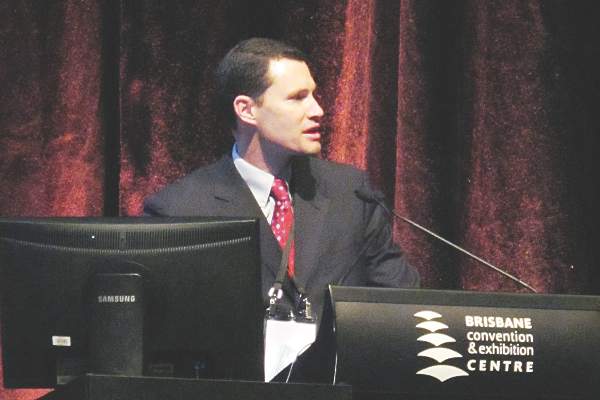User login
BRISBANE, AUSTRALIA – Evidence is building for a link between bacterial vaginosis and an increased risk of sexually transmitted infections, but clinical trial data demonstrating that treating vaginosis will reduce STI risk is still needed.
“We don’t expect that bacterial vaginosis is the direct cause of STIs but rather they influence their risk,” Dr. R. Scott McClelland of the University of Washington, Seattle, said at the World STI and HIV Congress 2015. “We’ve seen plenty of studies that make a nice temporal argument that bacterial vaginosis precedes STIs and some evidence of a biological gradient.”
He outlined some of the major studies that explore the relationship between bacterial vaginosis and HIV, herpes, gonorrhea, chlamydia, and trichomoniasis.
In the case of HIV, Dr. McClelland cited data from the Mombasa cohort of high-risk women in Kenya that suggested that bacterial vaginosis was the second largest contributor to HIV risk after herpes simplex virus type 2, representing around 17% of the population-attributable risk (AIDS. 2015 Jun 1;29[9]:1077-85. doi: 10.1097/QAD.0000000000000646). There is also evidence that HIV-positive women tended to have reduced vaginal lactobacilli and increased bacterial diversity, compared with women without HIV, he said.
Four major studies also showed a generally significant 1.6- to 2.4-fold increase in the risk of herpes simplex virus type 2 following bacterial vaginosis, Dr. McClelland said. Similarly with HPV infection, studies suggest a 1.2- to 2.4-fold increase in the risk of HPV infection after bacterial infection.
“With HPV, some of the most interesting new work is exploring how bacterial vaginosis may influence the outcomes of HPV infection in terms of progression towards cervical dysplasia and cervical cancer,” Dr. McClelland said.
The evidence is somewhat mixed for bacterial STIs, with some evidence for a link between bacterial vaginosis and chlamydia and gonorrhea.
There is strong but unadjusted evidence of a link between bacterial vaginosis and Mycoplasma genitalium infection from the Mombasa cohort study, which also showed a dose-response effect between Nugent score and Mycoplasma genitalium risk, he said.
“I think these data are really intriguing; I think that they suggest that we might be able to substantially reduce women’s risk of acquiring STIs if we could control their vaginal microbiota better,” Dr. McClelland said in an interview.
An audience member noted that the therapeutic armamentarium for bacterial vaginosis was not ideal, but asked at what point clinicians should start paying more attention to asymptomatic bacterial vaginosis.
“I don’t think we should start treating asymptomatic bacterial vaginosis without clear clinical trial evidence that there’s a benefit to doing that, and right now we don’t have it,” Dr. McClelland said.
Another study presented at the conference – coauthored by Dr. McClelland – has taken a step toward addressing this lack of evidence with a randomized controlled trial examining the impact of periodic presumptive treatment of bacterial vaginosis on STI risk.
Researchers randomized 221 women in Kenya and the United States who were not infected with HIV to intravaginal metronidazole plus miconazole, or placebo for 5 consecutive nights each month for a year. The intervention successfully reduced the incidence of bacterial vaginosis and achieved a significant reduction in the incidence of chlamydia and gonorrhea, but only when the two infections were assessed as a combined endpoint, according to Dr. McClelland.
Dr. McClelland reported receiving past consulting and lecture fees from Embil Pharmaceutical Co., and a current research grant from Hologic Inc.
BRISBANE, AUSTRALIA – Evidence is building for a link between bacterial vaginosis and an increased risk of sexually transmitted infections, but clinical trial data demonstrating that treating vaginosis will reduce STI risk is still needed.
“We don’t expect that bacterial vaginosis is the direct cause of STIs but rather they influence their risk,” Dr. R. Scott McClelland of the University of Washington, Seattle, said at the World STI and HIV Congress 2015. “We’ve seen plenty of studies that make a nice temporal argument that bacterial vaginosis precedes STIs and some evidence of a biological gradient.”
He outlined some of the major studies that explore the relationship between bacterial vaginosis and HIV, herpes, gonorrhea, chlamydia, and trichomoniasis.
In the case of HIV, Dr. McClelland cited data from the Mombasa cohort of high-risk women in Kenya that suggested that bacterial vaginosis was the second largest contributor to HIV risk after herpes simplex virus type 2, representing around 17% of the population-attributable risk (AIDS. 2015 Jun 1;29[9]:1077-85. doi: 10.1097/QAD.0000000000000646). There is also evidence that HIV-positive women tended to have reduced vaginal lactobacilli and increased bacterial diversity, compared with women without HIV, he said.
Four major studies also showed a generally significant 1.6- to 2.4-fold increase in the risk of herpes simplex virus type 2 following bacterial vaginosis, Dr. McClelland said. Similarly with HPV infection, studies suggest a 1.2- to 2.4-fold increase in the risk of HPV infection after bacterial infection.
“With HPV, some of the most interesting new work is exploring how bacterial vaginosis may influence the outcomes of HPV infection in terms of progression towards cervical dysplasia and cervical cancer,” Dr. McClelland said.
The evidence is somewhat mixed for bacterial STIs, with some evidence for a link between bacterial vaginosis and chlamydia and gonorrhea.
There is strong but unadjusted evidence of a link between bacterial vaginosis and Mycoplasma genitalium infection from the Mombasa cohort study, which also showed a dose-response effect between Nugent score and Mycoplasma genitalium risk, he said.
“I think these data are really intriguing; I think that they suggest that we might be able to substantially reduce women’s risk of acquiring STIs if we could control their vaginal microbiota better,” Dr. McClelland said in an interview.
An audience member noted that the therapeutic armamentarium for bacterial vaginosis was not ideal, but asked at what point clinicians should start paying more attention to asymptomatic bacterial vaginosis.
“I don’t think we should start treating asymptomatic bacterial vaginosis without clear clinical trial evidence that there’s a benefit to doing that, and right now we don’t have it,” Dr. McClelland said.
Another study presented at the conference – coauthored by Dr. McClelland – has taken a step toward addressing this lack of evidence with a randomized controlled trial examining the impact of periodic presumptive treatment of bacterial vaginosis on STI risk.
Researchers randomized 221 women in Kenya and the United States who were not infected with HIV to intravaginal metronidazole plus miconazole, or placebo for 5 consecutive nights each month for a year. The intervention successfully reduced the incidence of bacterial vaginosis and achieved a significant reduction in the incidence of chlamydia and gonorrhea, but only when the two infections were assessed as a combined endpoint, according to Dr. McClelland.
Dr. McClelland reported receiving past consulting and lecture fees from Embil Pharmaceutical Co., and a current research grant from Hologic Inc.
BRISBANE, AUSTRALIA – Evidence is building for a link between bacterial vaginosis and an increased risk of sexually transmitted infections, but clinical trial data demonstrating that treating vaginosis will reduce STI risk is still needed.
“We don’t expect that bacterial vaginosis is the direct cause of STIs but rather they influence their risk,” Dr. R. Scott McClelland of the University of Washington, Seattle, said at the World STI and HIV Congress 2015. “We’ve seen plenty of studies that make a nice temporal argument that bacterial vaginosis precedes STIs and some evidence of a biological gradient.”
He outlined some of the major studies that explore the relationship between bacterial vaginosis and HIV, herpes, gonorrhea, chlamydia, and trichomoniasis.
In the case of HIV, Dr. McClelland cited data from the Mombasa cohort of high-risk women in Kenya that suggested that bacterial vaginosis was the second largest contributor to HIV risk after herpes simplex virus type 2, representing around 17% of the population-attributable risk (AIDS. 2015 Jun 1;29[9]:1077-85. doi: 10.1097/QAD.0000000000000646). There is also evidence that HIV-positive women tended to have reduced vaginal lactobacilli and increased bacterial diversity, compared with women without HIV, he said.
Four major studies also showed a generally significant 1.6- to 2.4-fold increase in the risk of herpes simplex virus type 2 following bacterial vaginosis, Dr. McClelland said. Similarly with HPV infection, studies suggest a 1.2- to 2.4-fold increase in the risk of HPV infection after bacterial infection.
“With HPV, some of the most interesting new work is exploring how bacterial vaginosis may influence the outcomes of HPV infection in terms of progression towards cervical dysplasia and cervical cancer,” Dr. McClelland said.
The evidence is somewhat mixed for bacterial STIs, with some evidence for a link between bacterial vaginosis and chlamydia and gonorrhea.
There is strong but unadjusted evidence of a link between bacterial vaginosis and Mycoplasma genitalium infection from the Mombasa cohort study, which also showed a dose-response effect between Nugent score and Mycoplasma genitalium risk, he said.
“I think these data are really intriguing; I think that they suggest that we might be able to substantially reduce women’s risk of acquiring STIs if we could control their vaginal microbiota better,” Dr. McClelland said in an interview.
An audience member noted that the therapeutic armamentarium for bacterial vaginosis was not ideal, but asked at what point clinicians should start paying more attention to asymptomatic bacterial vaginosis.
“I don’t think we should start treating asymptomatic bacterial vaginosis without clear clinical trial evidence that there’s a benefit to doing that, and right now we don’t have it,” Dr. McClelland said.
Another study presented at the conference – coauthored by Dr. McClelland – has taken a step toward addressing this lack of evidence with a randomized controlled trial examining the impact of periodic presumptive treatment of bacterial vaginosis on STI risk.
Researchers randomized 221 women in Kenya and the United States who were not infected with HIV to intravaginal metronidazole plus miconazole, or placebo for 5 consecutive nights each month for a year. The intervention successfully reduced the incidence of bacterial vaginosis and achieved a significant reduction in the incidence of chlamydia and gonorrhea, but only when the two infections were assessed as a combined endpoint, according to Dr. McClelland.
Dr. McClelland reported receiving past consulting and lecture fees from Embil Pharmaceutical Co., and a current research grant from Hologic Inc.
EXPERT ANALYSIS FROM WORLD STI & HIV CONGRESS 2015

